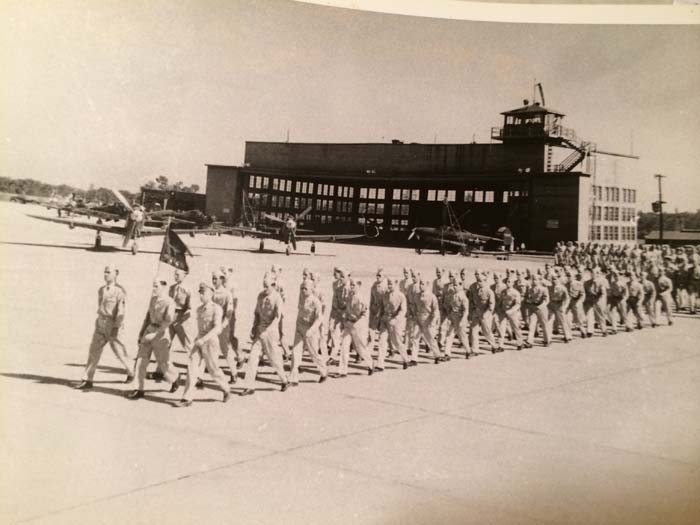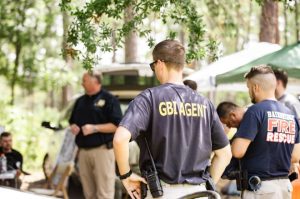A place to land
Published 6:24 pm Saturday, September 20, 2014

- At the original maintenance hangar, a class of cadets marches on the ramp in formation near where the control tower was located. P-39 aircraft are parked out front.
THOMASVILLE — As people were taking to the skies, the aircraft industry was taking flight, and Thomasville needed a place to land.
Before construction of the well-established, present-day Thomasville Regional Airport, there were two other locations for planes to land in Thomasville.
Trending
The first landing area was off Cassidy Road, north of Carroll Hill. However, the first organized airport was Vose Field.
Vose Field was an area donated by Greenwood Plantation. The Jock Whitney family of Greenwood Plantation had a plane they used on trips to and from New York and needed a place to land and depart. Airplanes also were slowly becoming more prominent.
The location of the airport was southwest of Thomasville, off Campbell Street, near the present-day industrial park. Later, the airport was named “Rose City Airport.”
As conflicts in Europe and Asia became more imminent, the U.S. government felt a need to promote aviation and air commerce. The creation of an airport in Thomasville originated from two government actions.
First, the government sought out communities where winters were mild to locate airports for general aviation and to expand airline routes. Secondly, in the event of a national emergency or war, the United States needed airports that could be used as military fields.
When the United States was forced into World War II, there was a great need for U.S. Army Air Corps and U.S. Navy bases. The Southeast had hundreds of air stations available — including Thomasville’s airport located off Pavo Road — which also served as a satellite field for Dale Mabry Field — known today as Tallahassee (Fla.) Regional Airport.
Trending
For many towns and cities, the legacy of World War II airfields allowed many cities, such as Thomasville, to have present-day airports.
Thomasville was chosen as the location of an advanced fighter training field. The field was for pilots who had army wings, but needed to be trained as single-seat flyers. Aerial combat fighting and bombing ranges were located in Brooks County, south of Quitman, and at Alligator Point, southwest of Tallahassee.
Several types of pursuit fighter planes were based at the Thomasville Army Air Base: The Bell, P-39 Air Cobra, The Curtis, P-40 War Hawk, P-51 Mustang and the famous North American.
By March 1943, construction had progressed to the point that the first plane landed at the air base. The base had its own community, which consisted of a maintenance shop, barracks and a chow hall. The facility was completely self-contained, with water and sewage systems, a fire department, hospital, commissary and theater.
When Army pilots left Thomasville in World War II, it was their last stop in training before being deployed to the European Theater and combat. The tour of duty in Thomasville was at first a 90-day program, but expanded into a 120-day program.
At the height of the operation, about 2,500 servicemen and a few army nurses called Thomasville Army Air Base home.
Through the years, many people who were stationed at the base have come through Thomasville on their way to Florida for vacations.
“Today, we know of no one who was based here in any capacity,” said Mike Woodham, Thomasville Regional Airport manager. “There were more than a few pilots and personnel who met women who would become their wives and make Thomasville their home.”
The base remained fully operational until the end of the war and officially closed on Sept. 30, 1945. It was declared abandoned on Nov. 30, 1945. It would never again be an official military base, but the U.S. Department of Defense maintained control until it was relinquished to the city and county in 1958.
The relinquishing allowed Thomasville to begin making plans to move from Rose City Airport on Campbell Street to the former Army Air Base off Pavo Road. In March 1961, renovations and construction of the new airport were completed. Rose City Airport closed and was considered abandoned.
Today, the layout of the runways and taxiways are as they were in 1945. Improvements included hangars, terminal and runway lighting. Some items at the present-day airport remain original from its days as an air base.
The rotating beacon tower and numerous hardstands, which were used to park ready-to-fly airplanes during the war, are still possible. Air Corps’ target butts or bullet traps remain today at the airport. Target butts or bullet traps were three-sided concrete bunkers filled with dirt used to test-fire machine guns from the aircraft.
James Dekle, founder of Power of the Past: Antique Aviation Museum, and Irvin NeSmith, flight instructor and former maintenance shop manager, both of Thomasville, have fond memories of working at the airport, contributing to its history.
Dekle recalled the large number of celebrities who flew into the Thomasville airport through the years.
“President (Dwight) Eisenhower, Jackie Kennedy, Jimmy Doolittle, Hubert Humphrey and many more landed at the airport. I remember a station wagon coming to pick (Jackie) Kennedy up from the airport and take her to Greenwood Plantation to visit with the Whitneys after President (John F.) Kennedy was killed,” said Dekle. “Eisenhower also came often to Greenwood Plantation for hunting. John Whitney would come pick him up.”
He also remembered a mysterious plane landing nearly 30 years ago.
Dekle said, “Me and my grandson watched a big airplane land one night. It was guarded with machine guns and state patrol officers. We watched it for a while, but never knew who was on that plane. No one ever said.”
In the past 53 years, Thomasville Regional Airport, previously known as Thomasville Municipal Airport, has evolved greatly with home-based aircraft and operations. Today, 58 planes based on the field.
Before becoming a corporate pilot, flight instructor and maintenance shop manager in 1982, NeSmith was a hobby pilot, who made flying his career. He has seen evolution of the airport through his years there.
He said, “The runways have been expanded, and now there is a landing system for bad weather, along with vertical and lateral guidance. We also have GPS approaches and security fences. What used to look like World War II barracks is now our new, nice terminal building. You’d think we were a quiet airport — but we have the same count as Valdosta.”
Most operations, which include activity and fuel sales, come from business and corporate aircraft — both home-based and transient.
Woodham added, “With total operations, meaning every take-off and landing, we average 14,000 per year. The bulk of traffic into Thomasville is in the fall and winter months, because we are still the center of the plantation quail industry. Many of the visitors live a substantial distance from Thomasville and fly here in their airplanes.”
With an average of 14,000 planes landing and departing each year, Thomasville Regional Airport stays busy and an historic staple to the community.
Anyone who has information on surviving servicemen or personnel based at Thomasville Army Air Base or has photographs or memorabilia that could be copied and shared is asked to contact Woodham at (229) 224-2428.






